2015.5 Peugeot 308 ECU
[x] Cancel search: ECUPage 140 of 396
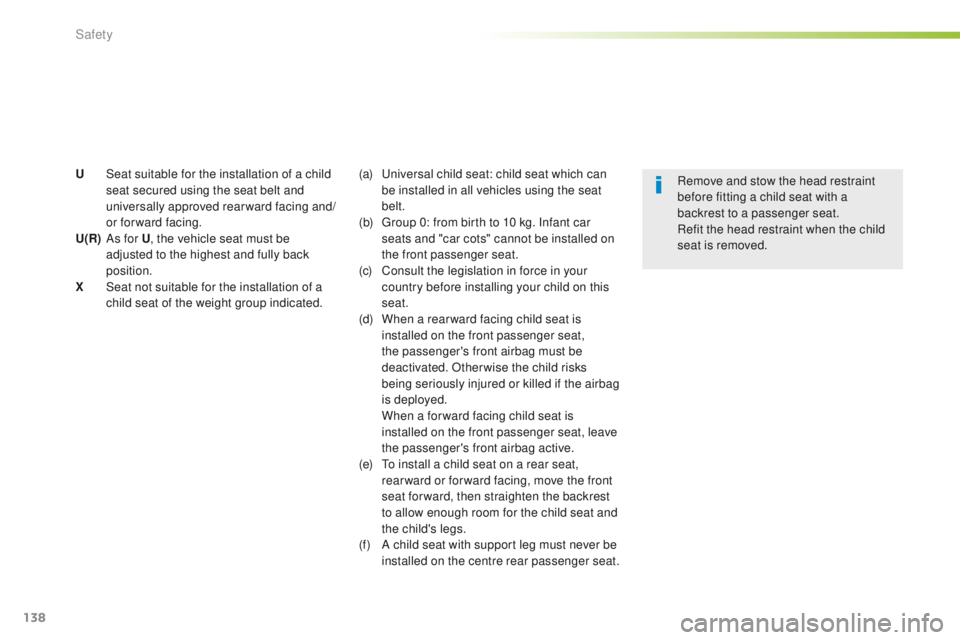
138
U Seat suitable for the installation of a child seat secured using the seat belt and
universally approved rearward facing and/
or forward facing.
U(R)
A
s for U, the vehicle seat must be
adjusted to the highest and fully back
position.
X
S
eat not suitable for the installation of a
child seat of the weight group indicated. Remove and stow the head restraint
before fitting a child seat with a
backrest to a passenger seat.
Refit the head restraint when the child
seat is removed.
(a)
un iversal child seat: child seat which can
be installed in all vehicles using the seat
belt.
(b)
g
r
oup 0: from birth to 10 kg. Infant car
seats and "car cots" cannot be installed on
the front passenger seat.
(c)
C
onsult the legislation in force in your
country before installing your child on this
seat.
(d)
W
hen a rear ward facing child seat is
installed on the front passenger seat,
the passenger's front airbag must be
deactivated. Otherwise the child risks
being seriously injured or killed if the airbag
is deployed.
W
hen a for ward facing child seat is
installed on the front passenger seat, leave
the passenger's front airbag active.
(e)
t
o i
nstall a child seat on a rear seat,
rear ward or for ward facing, move the front
seat for ward, then straighten the backrest
to allow enough room for the child seat and
the child's legs.
(f)
A c
hild seat with support leg must never be
installed on the centre rear passenger seat.
Safety
Page 141 of 396
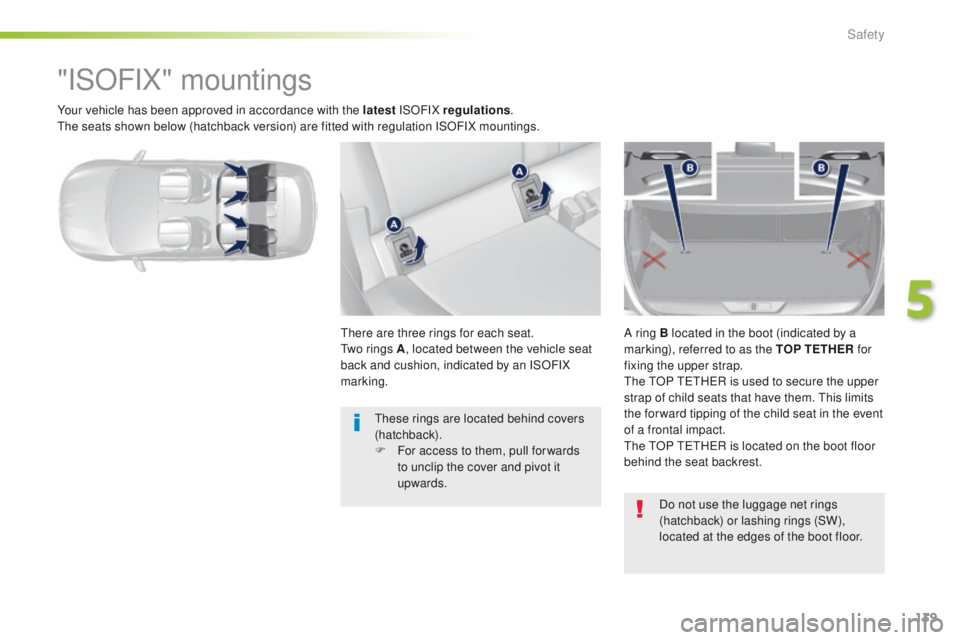
139
Your vehicle has been approved in accordance with the latest ISOFIX regulations.th
e seats shown below (hatchback version) are fitted with regulation ISOFIX mountings.
"ISOFIX" mountings
there are three rings for each seat.tw o rings A , located between the vehicle seat
back and cushion, indicated by an ISOFIX
marking. A ring B located in the boot (indicated by a
marking), referred to as the TOP TETHER for
fixing the upper strap.
th
e t
O
P tet
HeR i
s used to secure the upper
strap of child seats that have them.
t
h
is limits
the for ward tipping of the child seat in the event
of a frontal impact.
th
e t
O
P tet
HeR i
s located on the boot floor
behind the seat backrest.
Do not use the luggage net rings
(hatchback) or lashing rings (SW),
located at the edges of the boot floor.
th
ese rings are located behind covers
(hatchback).
F
F
or access to them, pull for wards
to unclip the cover and pivot it
upwards.
5
Safety
Page 142 of 396
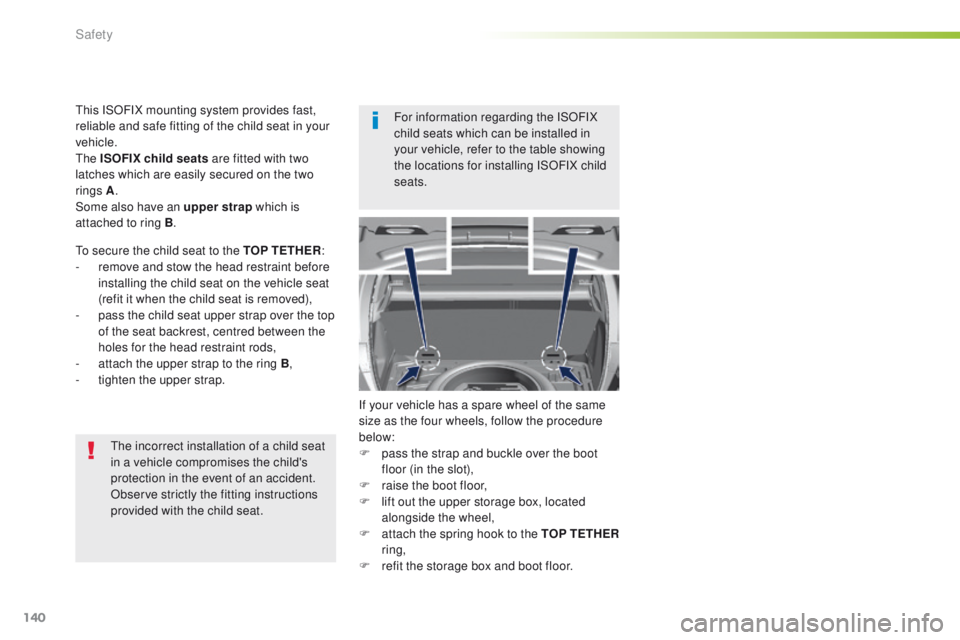
140
the incorrect installation of a child seat
in a vehicle compromises the child's
protection in the event of an accident.
Observe strictly the fitting instructions
provided with the child seat.
to s
ecure the child seat to the TOP TETHER
:
-
r
emove and stow the head restraint before
installing the child seat on the vehicle seat
(refit it when the child seat is removed),
-
p
ass the child seat upper strap over the top
of the seat backrest, centred between the
holes for the head restraint rods,
-
a
ttach the upper strap to the ring B,
-
t
ighten the upper strap.
If your vehicle has a spare wheel of the same
size as the four wheels, follow the procedure
below:
F p ass the strap and buckle over the boot
floor (in the slot),
F
r
aise the boot floor,
F
l
ift out the upper storage box, located
alongside the wheel,
F
a
ttach the spring hook to the TOP TETHER
ring,
F
r
efit the storage box and boot floor.
th
is ISOFIX mounting system provides fast,
reliable and safe fitting of the child seat in your
vehicle.
th
e ISOFIX child seats are fitted with two
latches which are easily secured on the two
rings A .
Some also have an upper strap which is
attached to ring B . For information regarding the ISOFIX
child seats which can be installed in
your vehicle, refer to the table showing
the locations for installing ISOFIX child
seats.
Safety
Page 143 of 396
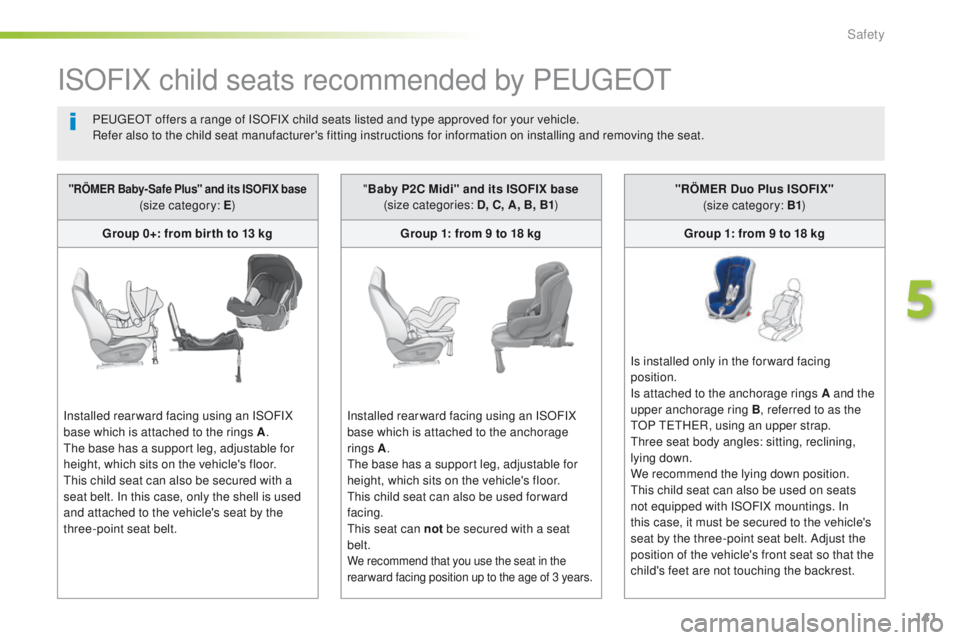
141
ISOFIX child seats recommended by PeugeOt
PeugeOt offers a range of ISOFIX child seats listed and type approved for your vehicle.
Refer also to the child seat manufacturer's fitting instructions for information on installing and removing the seat.
"RÖMER Baby- Safe Plus" and its ISOFIX base (size category: E)
Group 0+: from bir th to 13 kg
Installed rearward facing using an ISOFIX
base which is attached to the rings A .
th
e base has a support leg, adjustable for
height, which sits on the vehicle's floor.
th
is child seat can also be secured with a
seat belt. In this case, only the shell is used
and attached to the vehicle's seat by the
three-point seat belt. "
Baby P2C Midi" and its ISOFIX base
(size categories: D, C, A, B, B1 )
Group 1: from 9 to 18 kg
Installed rearward facing using an ISOFIX
base which is attached to the anchorage
rings A .
th
e base has a support leg, adjustable for
height, which sits on the vehicle's floor.
th
is child seat can also be used for ward
facing.
th
is seat can not be secured with a seat
belt.
We recommend that you use the seat in the
rear ward facing position up to the age of 3 years.
"RÖMER Duo Plus ISOFIX" (size category: B1 )
Group 1: from 9 to 18 kg
Is installed only in the for ward facing
position.
Is attached to the anchorage rings A and the
upper anchorage ring B , referred to as the
tO
P
tet
HeR
, using an upper strap.
th
ree seat body angles: sitting, reclining,
lying down.
We recommend the lying down position.
th
is child seat can also be used on seats
not equipped with ISOFIX mountings. In
this case, it must be secured to the vehicle's
seat by the three-point seat belt. Adjust the
position of the vehicle's front seat so that the
child's feet are not touching the backrest.
5
Safety
Page 145 of 396
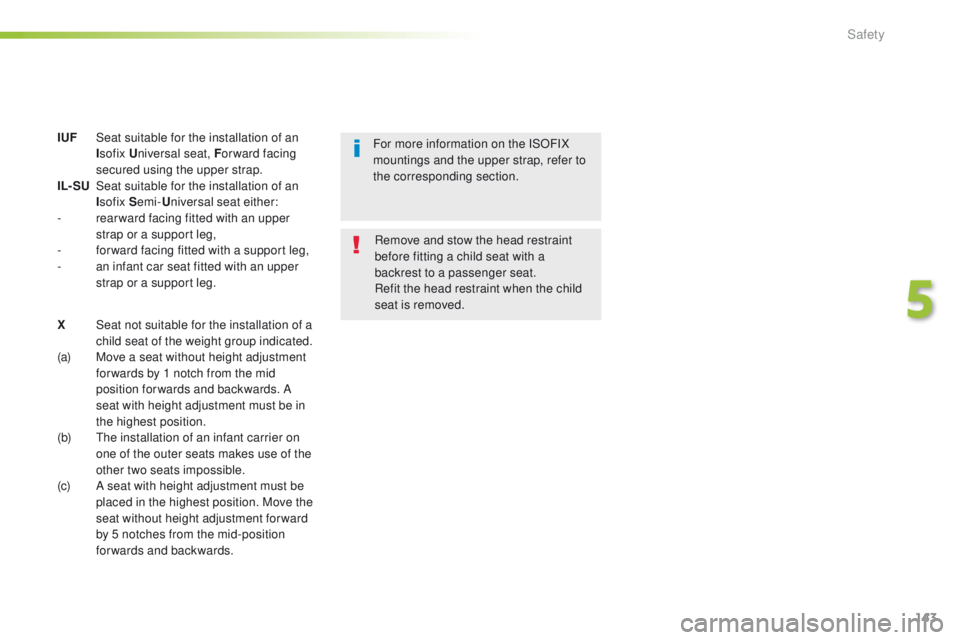
143
IUF Seat suitable for the installation of an Isofix U niversal seat, F or ward facing
secured using the upper strap.
IL- SU
S
eat suitable for the installation of an
I sofix S emi-Universal seat either:
-
r
ear ward facing fitted with an upper
strap or a support leg,
-
f
or ward facing fitted with a support leg,
-
a
n infant car seat fitted with an upper
strap or a support leg. For more information on the ISOFIX
mountings and the upper strap, refer to
the corresponding section.
X
S
eat not suitable for the installation of a
child seat of the weight group indicated.
(a)
M
ove a seat without height adjustment
for wards by 1 notch from the mid
position for wards and backwards. A
seat with height adjustment must be in
the highest position.
(b)
t
h
e installation of an infant carrier on
one of the outer seats makes use of the
other two seats impossible.
(c)
A s
eat with height adjustment must be
placed in the highest position. Move the
seat without height adjustment forward
by 5 notches from the mid-position
forwards and backwards. Remove and stow the head restraint
before fitting a child seat with a
backrest to a passenger seat.
Refit the head restraint when the child
seat is removed.
5
Safety
Page 146 of 396
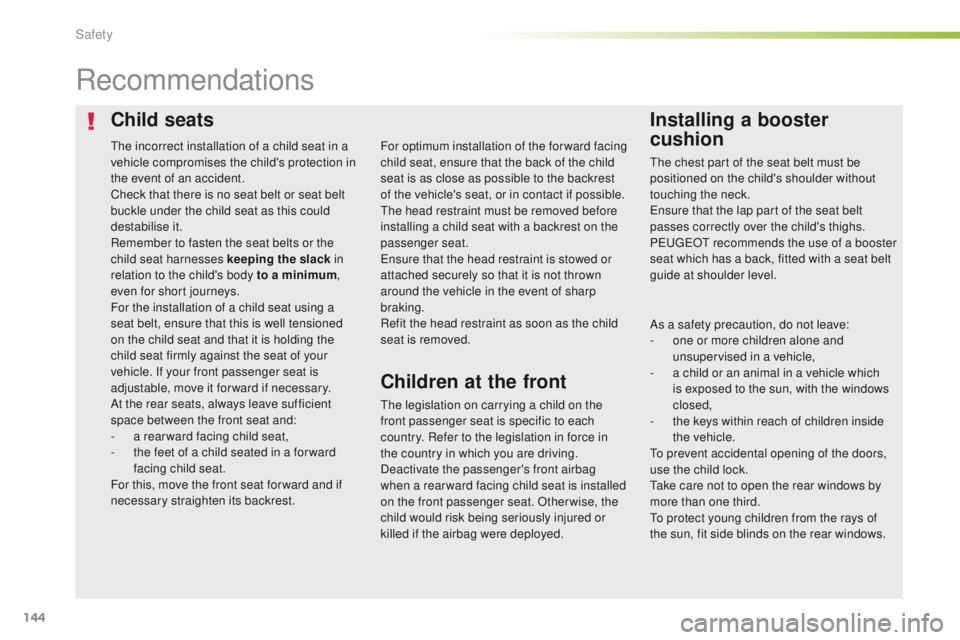
144
Child seatsInstalling a booster
cushion
Recommendations
the legislation on carrying a child on the
front passenger seat is specific to each
country. Refer to the legislation in force in
the country in which you are driving.
Deactivate the passenger's front airbag
when a rear ward facing child seat is installed
on the front passenger seat. Otherwise, the
child would risk being seriously injured or
killed if the airbag were deployed. For optimum installation of the forward facing
child seat, ensure that the back of the child
seat is as close as possible to the backrest
of the vehicle's seat, or in contact if possible.
th
e head restraint must be removed before
installing a child seat with a backrest on the
passenger seat.
en
sure that the head restraint is stowed or
attached securely so that it is not thrown
around the vehicle in the event of sharp
braking.
Refit the head restraint as soon as the child
seat is removed.
th
e incorrect installation of a child seat in a
vehicle compromises the child's protection in
the event of an accident.
Check that there is no seat belt or seat belt
buckle under the child seat as this could
destabilise it.
Remember to fasten the seat belts or the
child seat harnesses keeping the slack in
relation to the child's body to a minimum ,
even for short journeys.
For the installation of a child seat using a
seat belt, ensure that this is well tensioned
on the child seat and that it is holding the
child seat firmly against the seat of your
vehicle. If your front passenger seat is
adjustable, move it forward if necessary.
At the rear seats, always leave sufficient
space between the front seat and:
-
a r
ear ward facing child seat,
-
t
he feet of a child seated in a for ward
facing child seat.
For this, move the front seat for ward and if
necessary straighten its backrest.
Children at the front
the chest part of the seat belt must be
positioned on the child's shoulder without
touching the neck.
en
sure that the lap part of the seat belt
passes correctly over the child's thighs.
P
e
uge
Ot
recommends the use of a booster
seat which has a back, fitted with a seat belt
guide at shoulder level.
As a safety precaution, do not leave:
-
o
ne or more children alone and
unsupervised in a vehicle,
-
a c
hild or an animal in a vehicle which
is exposed to the sun, with the windows
closed,
-
t
he keys within reach of children inside
the vehicle.
to p
revent accidental opening of the doors,
use the child lock.
ta
ke care not to open the rear windows by
more than one third.
to p
rotect young children from the rays of
the sun, fit side blinds on the rear windows.
Safety
Page 163 of 396
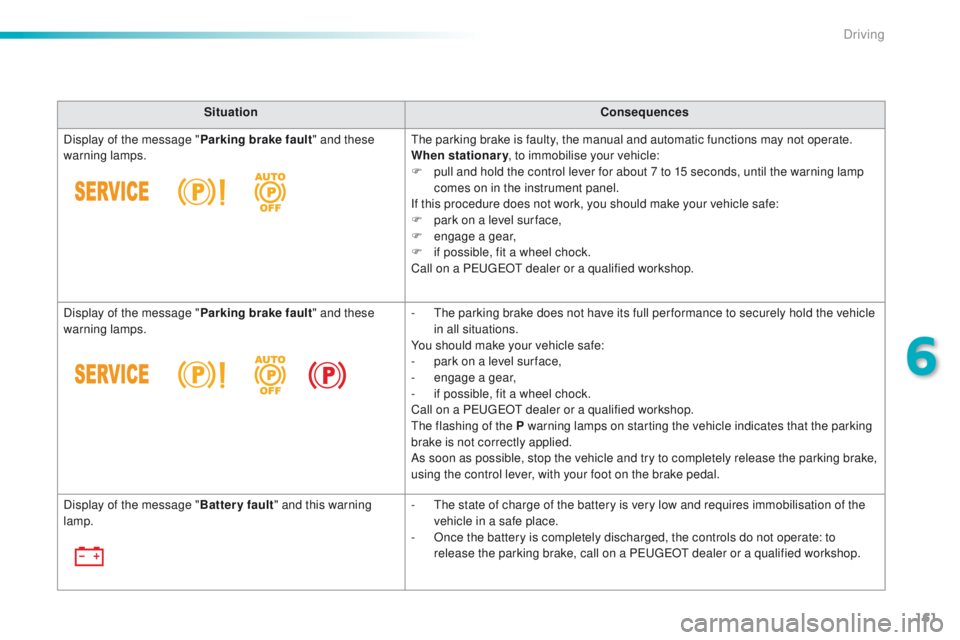
161
SituationConsequences
Display of the message " Parking brake fault" and these
warning lamps.
th
e parking brake is faulty, the manual and automatic functions may not operate.
When stationary , to immobilise your vehicle:
F
p
ull and hold the control lever for about 7 to 15 seconds, until the warning lamp
comes on in the instrument panel.
If this procedure does not work, you should make your vehicle safe:
F
p
ark on a level sur face,
F
enga
ge a gear,
F
i
f possible, fit a wheel chock.
Call on a P
e
uge
Ot
dealer or a qualified workshop.
Display of the message " Parking brake fault" and these
warning lamps. -
t
h
e parking brake does not have its full per formance to securely hold the vehicle
in all situations.
You should make your vehicle safe:
-
p
ark on a level sur face,
-
enga
ge a gear,
-
i
f possible, fit a wheel chock.
Call on a P
e
uge
Ot
dealer or a qualified workshop.
th
e flashing of the P warning lamps on starting the vehicle indicates that the parking
brake is not correctly applied.
As soon as possible, stop the vehicle and try to completely release the parking brake,
using the control lever, with your foot on the brake pedal.
Display of the message " Battery fault" and this warning
lamp. -
t
h
e state of charge of the battery is very low and requires immobilisation of the
vehicle in a safe place.
-
O
nce the battery is completely discharged, the controls do not operate: to
release the parking brake, call on a P
e
uge
Ot
dealer or a qualified workshop.
6
Driving
Page 178 of 396
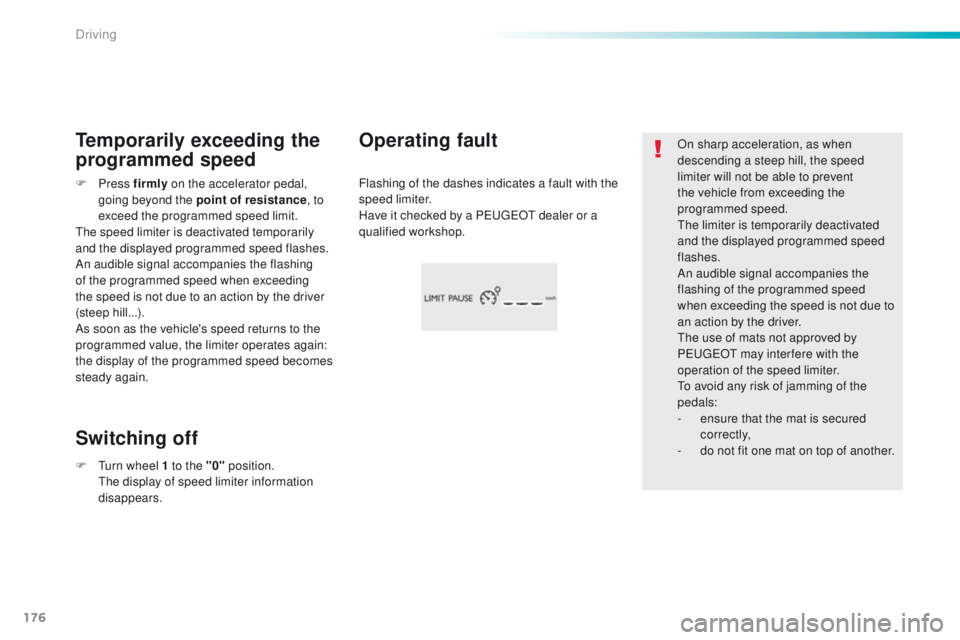
176
On sharp acceleration, as when
descending a steep hill, the speed
limiter will not be able to prevent
the vehicle from exceeding the
programmed speed.
the
limiter is temporarily deactivated
and the displayed programmed speed
flashes.
An audible signal accompanies the
flashing of the programmed speed
when exceeding the speed is not due to
an action by the driver.
th
e use of mats not approved by
P
e
uge
Ot
may inter fere with the
operation of the speed limiter.
to a
void any risk of jamming of the
pedals:
-
e
nsure that the mat is secured
c o r r e c t l y,
-
d
o not fit one mat on top of another.
Flashing of the dashes indicates a fault with the
speed limiter.
Have it checked by a P
e
uge
Ot
dealer or a
qualified workshop.Operating fault
Temporarily exceeding the
programmed speed
Switching off
F Press f irmly on the accelerator pedal,
going beyond the point of resistance ,
to
exceed the programmed speed limit.
th
e speed limiter is deactivated temporarily
and the displayed programmed speed flashes.
An audible signal accompanies the flashing
of the programmed speed when exceeding
the speed is not due to an action by the driver
(steep hill...).
As soon as the vehicle's speed returns to the
programmed value, the limiter operates again:
the display of the programmed speed becomes
steady again.
F
t
u
rn wheel 1 to the "0" position.
t
h
e display of speed limiter information
disappears.
Driving